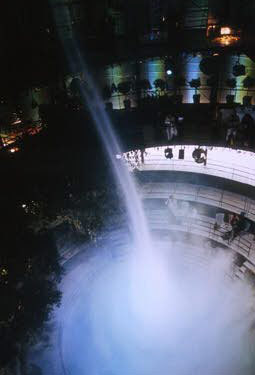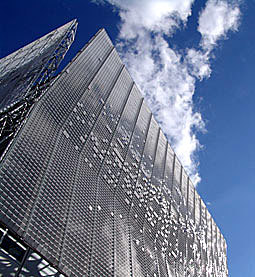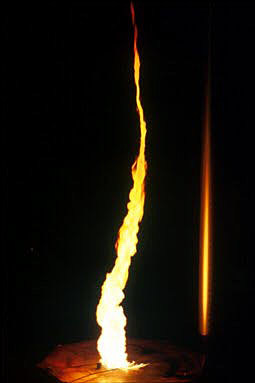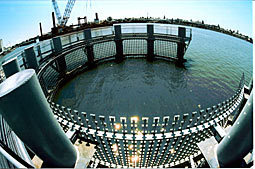 {Duales Systems Pavilion - EXPO 2000, Hannover, Germany. 2000}
{Duales Systems Pavilion - EXPO 2000, Hannover, Germany. 2000}
A repetitive theme here at D.U.S. and one I've been interested in my whole life is the interaction/bond/connection- whatever, that we have with nature. Whether its how it effects us, or we effect it, or if we are just one element of nature, the elemental forces that construct and deconstruct built environments is of great fascination.
I am also quite fond of environmental artists, and if I had the balls, or the any talent for that matter it would be something I would pursue. Since I don't, I bask in the works of Andy Goldsworthy among others to develop a greater understanding of the intracacies of nature and our connectedness.
A new-to-me artist is Ned Kahn. An artist from Northern California, Kahn replicates the forms and forces of nature. Studying systems that happen naturally, and what effect even the smallest influence that man can have on that system, Kahn's work is both performance art of choreographed natural phenomena, and controlled simulation for understanding the earth's elemental forces.
 {Articulated Cloud - Pittsburgh Children’s Museum, Pittsburgh, PA. 2004}
{Articulated Cloud - Pittsburgh Children’s Museum, Pittsburgh, PA. 2004}
Through his project Tornado (1990) Kahn re-creates dynamic wind currents. Tornado, a sleek, 12-foot-high structure containing a dancing airborne funnel of whirling fog, air blowers inside the work's upper and lower platforms create a strong updraft, while a fog generator introduces water vapour into the resulting vortical airflow. With no glass or other barriers between viewers and the vortex, the installation invites interaction with the resulting mini-twister. "If you gently run your hand through it, it will curve and recover", Kahn explains. "But if you jump through it or wave your hands rapidly inside it, you completely disrupt the airflow, and it disappears. Sometimes it takes many minutes before the vortex can reorganise itself. With elegant simplicity, Kahn's Tornado illustrates the Butterfly Effect.
I see Kahn's work as the perfect anecdote to a copious amount of iconic water and public art features, representing something maybe but teaching us nothing. Through Kahn's scientific background, he's able to tame the wild and create a visual display of natural complexities. He's able to take unseen forces like wind, and make them visible with the use of moving parts and light.
For many environmental artists the creation of the works in remote areas requiring a journey to witness them is part of experience, which I love. But Kahn's work on the other hand has been built in the public realm and more accessible to those otherwise without the fortitude or inclination to travel for the experience. After viewing one of his installations, I'd imagine it to open your eyes for when we see elemental systems in natural occurrence with a stronger affinity and understanding.
 {Prism Tunnel - Children’s Garden, Huntington Botanical Gardens, San Marino, California. 2004}
{Prism Tunnel - Children’s Garden, Huntington Botanical Gardens, San Marino, California. 2004}
 {Fire Vortex - Technorama, Winterthur, Switzerland. 1997}
{Fire Vortex - Technorama, Winterthur, Switzerland. 1997}
 {Wave Oculus - Union Point Pier, Oakland, California. 2006}
{Wave Oculus - Union Point Pier, Oakland, California. 2006}
Kahn's artist statement, incomparably more poetic then I would could ever summarize:
The confluence of science and art has fascinated me throughout my career. For the last fifteen years, I have developed a body of work inspired by atmospheric physics, geology, astronomy and fluid motion. I strive to create artworks that enable viewers to observe and interact with natural processes. I am less interested in creating an alternative reality than I am in capturing, through my art, the mysteriousness of the world around us.
My artworks frequently incorporate flowing water, fog, sand and light to create complex and continually changing systems. Many of these works can be seen as "observatories" in that they frame and enhance our perception of natural phenomena. I am intrigued with the way patterns can emerge when things flow. These patterns are not static objects, they are patterns of behavior - recurring themes in nature.
Be sure to check out the videos featured on his site
Related: Rivers and Tides
